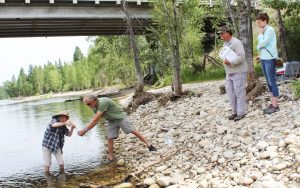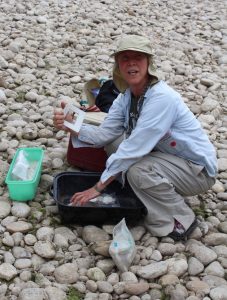
The Montana Department of Environmental Quality (DEQ) has initiated the implementation of a 20-yearlong water quality monitoring project on the mainstem of the Bitterroot River. The agency is taking samples for nutrient testing from five sites on the river’s mainstem including sites at the USGS gauge south of Darby and at the bridges at Main Street in Hamilton, Bell Crossing, Florence and Buckhouse. The sampling design and primary objective of this monitoring effort is to detect long-term trends in nutrient and benthic algae chlorophyll concentrations in the Bitterroot River.

According to the plan, sampling results will be published annually with a trend analysis produced every five years. The impetus behind establishing a long-term nutrient monitoring program on the Bitterroot River is supported by the agency’s Monitoring and Assessment (MAS) Program’s and Nonpoint Source (NPS) Program’s strategic longterm plans. One of MAS’s stated strategic plan objectives are to track water quality change over time, particularly in watersheds where multiple DEQ program priorities align. Over the next 2-3 years, a majority of the NPS Program’s financial and technical resources will be focused in the watershed, thereby increasing momentum for education and outreach and voluntary restoration implementation. A major goal of the Bitterroot Mainstem Long-term Nutrient Trends Monitoring Project is to help demonstrate the success of this effort.
DEQ has been doing similar monitoring in the mainstem of the Clark Fork River since 1993 and continues to monitor that river with help from the Clark Fork Coalition, Avista and the University of Montana Watershed Health Clinic. In 2016, the Bitterroot River Protection Association (BRPA) expressed an interest in extending that monitoring effort up the Bitterroot. While the laboratory personnel at the Missoula wastewater treatment laboratory continued to monitor at Maclay and Buckhouse bridges, BRPA volunteers undertook monitoring at the Darby gage site, Main Street and Veterans bridges in Hamilton and at the Florence bridge. When funding for the project lapsed in 2018, BRPA continued the monitoring at its own expense.
“We thought it was important to keep the data coming in,” said BRPA executive director Michael Howell. “We really believed that the river should be monitored annually in perpetuity, but we also realized what a daunting task that would be, especially if we were paying for it ourselves.”
What happened was serendipitous, according to Howell. The Bitterroot College sponsored its first community Water Symposium and BRPA was invited to attend and make a presentation at the symposium.
“We presented our vision of a locally funded water quality monitoring program that would monitor the nutrient levels in the Bitterroot River in perpetuity and the response from the college, from local businesses, and from other organizations was immediate,” said Howell. The result was the formation of the Bitterroot River Health Check cooperative that includes BRPA, Bitterroot Trout Unlimited, Bitterrooters for Planning and the Bitterroot College as well as contributions from local businesses and individuals.

Howell said the response from the community at large to their efforts was also tremendous. He said they had no trouble getting volunteers and about 15 people received training from DEQ in water sampling protocols that year.
“I also had several people approach me about monitoring the streams that run by their homes,” said Howell. “With such intense interest being expressed, we decided to expand our operation and designed a plan for monitoring six streams spanning the west side of the valley. Each stream has a dedicated ‘Creekkeeper’ who lives along the stream and supervises the collection of samples at two sites on the stream, one near the Forest Service boundary and another near the stream’s mouth where it flows into the river.”
Howell said he was told by DEQ at the time, that if BRPA could keep the monitoring going on the mainstem for a year, the agency was considering resuming the project.
“So we did keep it going,” said Howell, “but what they came back with was completely unexpected. It may not be a commitment to monitor in perpetuity, but a twenty-year plan with a ten-year renewable budget is a very big deal.”
Under DEQ’s current plan, Bitterroot River Health Check volunteers will be taking samples at five bridges along the river at the Darby gage site, Hamilton Main Street, Bell Crossing, Florence bridge and Buckhouse bridge. Bitterroot River Health Check program has added an additional sampling site along the river at the Veteran’s bridge at its own expense. The organization will also continue the monitoring at 11 sites on the tributaries, which includes Three Mile Creek, North Burnt Fork Creek, Willow Creek, Skalkaho Creek, Rye Creek and North Rye Creek.
Rye Creek and Three Mile Creek were identified as top tier priorities in the Bitterroot Recovery Plan. North Burnt Fork and Skalkaho Creeks are identified in the Tier 2 priorities for recovery efforts. Willow Creek is the only creek being sampled that is not currently designated as impaired for nutrients.
“What we are doing, the data we are gathering, will not only be used to help guide future recovery efforts,” said Howell, “but it can also be used to assess the results. With DEQ backing us for a few years under their focused funding strategy we have a very good chance of establishing a water quality monitoring program that really can keep on keeping on forever perhaps. That’s our dream anyway.”